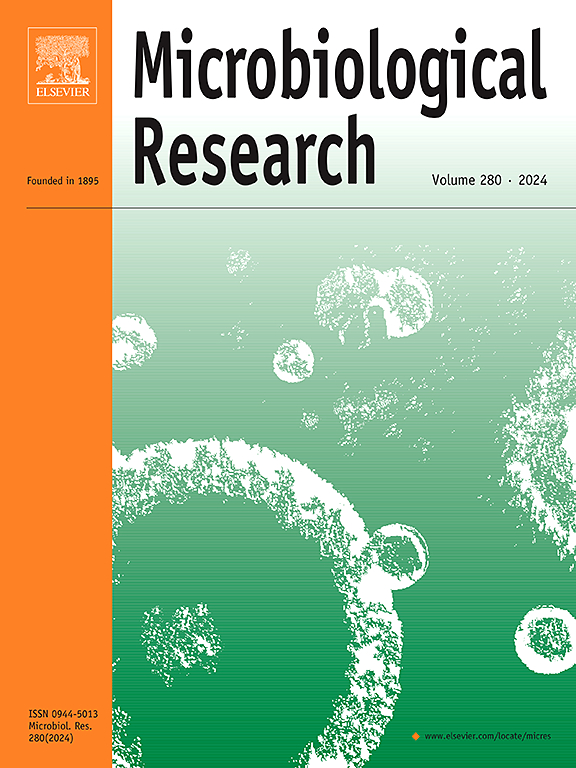木霉与茶根相关菌共接种可提高茶(Camellia sinensis)的类黄酮产量和菌根定植丰度。
IF 6.1
1区 生物学
Q1 MICROBIOLOGY
引用次数: 0
摘要
茶是最受欢迎的非酒精饮料之一,它含有几种重要的药用类黄酮。由于季节变化和各种环境胁迫,茶总黄酮的整体浓度影响茶叶品质。为了对抗压力,植物刺激与根相关的有益微生物群的共生关系,维持营养分配。因此,一项研究旨在了解茶根微生物群在维持茶叶类黄酮生产中的作用。在印度西孟加拉邦Jalpaiguri地区收集了3年健康茶树的根和根面土壤,以枚举微生物组。采用不依赖培养的方法鉴定根和根际微生物多样性(biossample: SAMN31404869;SRA: SRS15503027[根际土壤宏基因组]生物样本:SAMN31404868;SRA:SRS15503030[根宏基因组]除微生物种类多样外,所采集的根样品中主要有4种菌根真菌,即Glomus intraradices、Glomus irregulare、Paraglomus occultum和Scutellospora heterogama。采用培养依赖法分离了几种植物促生长细菌[Bacillus sp. D56, Bacillus sp. D42, Bacillus sp. DR15, Rhizobium sp. DR23 (NCBI Accession: OR821747-OR821750)]和一种真菌[Trichoderma sp. AM6 (NCBI Accession:OM915414)]菌株。设计了一个盆栽实验来评估分离的微生物组对茶苗的影响。接种微生物组6个月后,对茶树的理化和转录参数进行了评价。结果表明,微生物组处理[t1 -无任何微生物接种;NCBI Accession: SAMN33591153), Trichoderma sp. AM6 (T2;NCBI收录号:SAMN33591155)和木derma sp. AM6 +含茶根的VAM +合成微生物联合体(T5;NCBI加入:SAMN33591154)]可以通过上调与茶叶类黄酮生物合成途径相关的转录物来提高茶叶幼苗中总黄酮的含量。本文章由计算机程序翻译,如有差异,请以英文原文为准。
Co-inoculation of Trichoderma and tea root-associated bacteria enhance flavonoid production and abundance of mycorrhizal colonization in tea (Camellia sinensis)
Tea is one of the most popular nonalcoholic beverages, that contains several medicinally important flavonoids. Due to seasonal variation and various environmental stresses, the overall consistency of tea flavonoids affects the tea quality. To combat stress, plants stimulate symbiotic relationships with root-associated beneficial microbiomes that sustain nutrient allocation. Therefore, a study has been designed to understand the role of the tea root microbiome in sustaining tea leaf flavonoid production. To enumerate the microbiome, tea root and rhizoplane soil were collected from 3 years of healthy plants from Jalpaiguri district, West Bengal, India. A culture-independent approach was adopted to identify root and rhizosphere microbial diversity (BioSample: SAMN31404869; SRA: SRS15503027 [rhizosphere soil metagenome] BioSample: SAMN31404868;SRA:SRS15503030 [root metagenome]. In addition to diverse microbes, four mycorrhiza fungi, i.e., Glomus intraradices, Glomus irregulare, Paraglomus occultum and Scutellospora heterogama were predominant in collected root samples. A culture-dependent approach was also adopted to isolate several plant growth-promoting bacteria [Bacillus sp. D56, Bacillus sp. D42, Bacillus sp. DR15, Rhizobium sp. DR23 (NCBI Accession: OR821747-OR821750)] and one fungal [Trichoderma sp. AM6 (NCBI Accession:OM915414)] strain. A pot experiment was designed to assess the impact of that isolated microbiome on tea seedlings. After six months of microbiome inoculation, tea plants' physicochemical and transcriptional parameters were evaluated. The results confer that the microbiome-treated treatments [(T1-without any microbial inoculation; NCBI Accession: SAMN33591153), Trichoderma sp. AM6 (T2; NCBI Accession: SAMN33591155) and Trichoderma sp. AM6 +VAM containing tea root+synthetic microbial consortia (T5; NCBI Accession: SAMN33591154)] could enhance the total flavonoid content in tea seedlings by upregulating certain transcripts associated with the flavonoid biosynthesis pathway of tea.
求助全文
通过发布文献求助,成功后即可免费获取论文全文。
去求助
来源期刊

Microbiological research
生物-微生物学
CiteScore
10.90
自引率
6.00%
发文量
249
审稿时长
29 days
期刊介绍:
Microbiological Research is devoted to publishing reports on prokaryotic and eukaryotic microorganisms such as yeasts, fungi, bacteria, archaea, and protozoa. Research on interactions between pathogenic microorganisms and their environment or hosts are also covered.
 求助内容:
求助内容: 应助结果提醒方式:
应助结果提醒方式:


